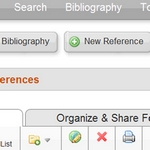RefWorks
RefWorks is a web-based bibliography and database manager that allows you to create a personal, searchable database of citations. These citations can be formatted into your Microsoft Word documents as footnotes or a custom bibliography.
Because it is entirely web-based (i.e. the bibliographic records reside on the web, not on your computer), it gives you access to your bibliographies from Mac, PC, or UNIX, as long as it’s connected to the Internet. To be safe, be sure to backup files. RefWorks also offers a mobile platform.
Stanford Libraries maintains a site license to RefWorks. If you are new to RefWorks, then you may want to start with the new (beta) RefWorks, which was released in 2016. (See below for more information.) To get started with the current (legacy) RefWorks, use your Stanford email to create your RefWorks account. For more information see the RefWorks LibGuide or view a RefWorks video tutorial.
Documentation and tutorials:
Additional help is available directly from RefWorks via email or phone toll free: 800-521-0600, ext. 7440 or direct 734-997-4440
RefWorks on Facebook and Twitter
New version of RefWorks: Fall 2016 update
The initial release of a "new" RefWorks platform became available on January 18, 2016. The current (legacy) RefWorks platform is unaffected: new accounts may be created and existing RefWorks accounts remain unchanged. The new RefWorks is expected to receive updates into 2017 which will add current (legacy) RefWorks features now lacking in the new RefWorks, i.e. ability to create multiple accounts; ability to attach image, audio, and video files; ability to attach multiple files to a record; ability to browse and search indexes for author, periodical title, or descriptor; ability to apply global edits; ability to de-duplicate upon import; etc. The current (legacy) RefWorks platform is expected to retire in 2018.
The new RefWorks includes features that are not available in the current (legacy) RefWorks, i.e. drag-and-drop uploading of pdfs, tools for pdf notes and highlighting, simultaneous group document editing, a Google Docs add-in to complement the Word add-in, and the ability to save webpages in 'distraction free' mode (no ads or navigation).
To explore the new RefWorks, use your Stanford email to create your new RefWorks login. You will have the option to import references from a legacy RefWorks account, both during the new account set-up as well as anytime from within the new account. Importing references into the new platform will not affect your current (legacy) RefWorks account. You may continue to work in your current (legacy) RefWorks account and use the import feature to regularly move changes from your legacy account into your new RefWorks account.
Warning: while you can use both current (legacy) and new RefWorks accounts, if you have started a document with references formatted via Write-n-Cite in your legacy RefWorks account, then complete your document using the legacy account, and vice versa. The format encoding for the new RefWorks is not yet compatible with the encoding used in the current (legacy) RefWorks, although compatibility is expected by Spring 2017.
The new RefWorks was originally called Flow. All previously-created Flow accounts exist on the new RefWorks platform. To access your Flow references, use your Flow login and password on the new RefWorks platform. A user guide (pdf) for a smoother transition from Flow to the new RefWorks is available.
Documentation and tutorials
NOTE: A problem with the pdf drag-and-drop feature in the new RefWorks was observed at the start of Fall 2016 and persisted into October, with uploaded pdfs stalling at the "analyzing..." phase. The issue appears to have been resolved by October 21, 2016. If you experience a recurrence of this issue, please email RefWorks customer support.


 Stanford University Home
Stanford University Home